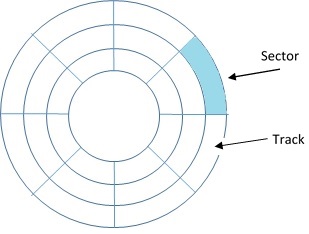Ordinarily, heat and electronics aren’t the best of companions; even less unsuited partners are heat and some magnetic materials!
However, a new technology being developed by Seagate for the next generation of storage devices, known as ‘heat-assisted magnetic recording’ is breaking the convention. The technology is heralded as revolutionary and could significantly increase the amount of data that can be stored on a hard drive by increasing storage density.
How a hard drive works
A regular magnetic recording hard disk drive works by magnetising a thin film of ferromagnetic material on a disk. The film, known as a platter includes hundreds of tracks and sectors, each track can be visualised by a concentric ring and each sector is a section of a ring, represented below.
Each sector has many tiny individual magnetic cells which are magnetised by the drives read/write head when data is written to the drive. Each write is completed by magnetising a number of these cells in a sequence of north or south directions. Data is then read from the disk by detecting the transitions in direction of magnetisation from cell to cell.
As storage density of modern drives continues to grow at an incredible rate, soon data bits will have to become so small that they will be magnetically unstable. Heat-assisted technology could significantly extend the capacity of modern drives that use magnetic heads to read and write digital data on spinning discs.

Lasers and magnets hold the key
Seagate’s solution is to use a more substantial (and stable) magnetic medium, however current devices are not able to write to such media. Heat-assisted magnetic recording gets around this problem by using a highly focused laser beam to heat the precise cell where data is being recorded. When the magnetic cell being recorded is heated, its individual coercivity is reduced making it easier to change their direction of magnetism, essentially making each cell easier to write too. Following the write process the cells are rapidly cooled, locking the written data in place.
Heat-assisted magnetic recording will allow manufacturers to cram even more bits of information, individual magnetic cells, into hard disk drives. This could result in storage densities as great as 50 terabits per square inch and 20TB hard drives by 2020 according to Seagate, the company leading the research.
If you’ve got an old hard drive, did you know that you can retrieve the neodymium magnets from it? We’ll be shortly following this post with our guide to retrieving neodymium magnets from your old hard drives so watch this space. Alternatively follow us to get our blog articles direct your news feed.
For the most comprehensive technical information about magnets, visit the first4magnets.com Tech Centre.


